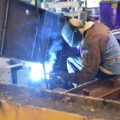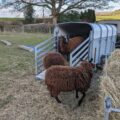by Lynn Broom
Longmead Veterinary Practice.
It can be difficult to know when to get a lump checked out. A general guideline can be helpful to know when to seek help. Dogs can get many types of lumps. Broadly speaking, small, slow-growing lumps are less likely to be a problem whereas ones that grow rapidly should be checked out.
Benign tumours are those that stay in their primary location without invading other sites of the body. They are less likely to cause a problem unless they affect another structure such as a joint or an eye, or grow so large that they ulcerate. Malignant tumours have cells that grow uncontrollably and spread locally and/or to distant sites.
Common benign lumps are wart-like structures, cysts and lipomas – fatty lumps – and these rarely cause problems unless they get knocked and bleed, interfere with mobility or grow so large that they affect quality of life.
Warts are slow-growing discoloured scaley or ‘frilly’ structures often just visible within the hair. Skin cysts often appear as a lump within the skin which is smooth and often still hairy. These may be present all the dog’s life without causing a problem but some will get traumatised and burst, often with secondary infection. Once burst they may not settle and may then need removing.
Lipomas are common and occur in increasing numbers with age. They are soft mobile lumps under – but not attached to – the skin. Some breeds such as Labradors are prone to developing multiple ones. Being overweight generally increases the size but not the number. They tend to grow slowly and rarely cause problems.
Tumours are more common in older animals. There are a few, however, which are more likely to develop in younger dogs, particularly in certain breeds. Histiocytomas are a tumour-like growth that commonly develop on young dogs. They typically appear as a raised red ‘plaque’ which is often itchy and the dog may self-traumatise the lesion. These will commonly regress after three or so months but they are often removed because of their location – often occurring on feet or ears – ongoing irritation and because of their resemblance to mast cell tumours.
Mast cell tumours can vary in appearance and can occur in young dogs, particularly in certain breeds such as Boxers. These often resemble histiocytomas but can be highly malignant. A fine needle aspirate (FNA) collection of cells with a needle, often done conscious, is frequently non-diagnostic in this type of mass and surgical removal with lab assessment of microscopic appearance is always recommended.
FNAs of many other masses can be very helpful for diagnosis. Lipomas particularly are easily diagnosed with an FNA. Some masses such as sarcomas cannot be diagnosed with FNA because they do not ‘shed’ cells readily and samples are non-diagnostic.
Firm lumps that can be felt under the angle of the jaw on one or both sides should be checked out. These may be a sign of infection within the mouth or skull or could be an indication of lymphoma.
Lumps under the tail should also be checked out. These can include anal gland abscesses, anal adenomas – common in older entire male dogs – and anal adenocarcinomas which can be malignant.
Any sore under the tail or around the anus needs investigation in order to provide appropriate treatment because pain or obstruction here can lead to defaecation problems.
Any new, rapidly growing lump or an existing but recently changed lump should be assessed. If in any doubt contact your vet for assessment.











Leave a Reply